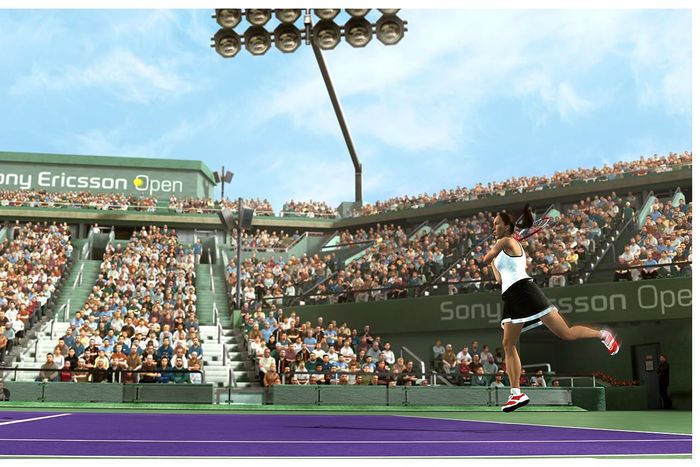
The U.S. Open season always compels me to pick up a tennis racquet. No, I don’t really know how to play the sport. I grew up with badminton, which isn’t particularly recognized in this country, and these days, I’m more prone to jump into a game of pickleball, a.k.a. the “garbage psy-op NFT” sport that’s been bottling up a ton of venture capital lately. (What can I say? It’s good for my knees, and crushing my elderly neighbors is super fun.) But watching tennis demigods duke it out in Queens every year never fails to light a fire in my belly, which I usually stoke by grabbing a friend and trying to hit a few strokes. It never works out well. So this year, I figured I’d follow up with the next best thing and find a damn good tennis video game to play.
According to certain pockets of the internet, the verdict is clear: The greatest tennis video game of all time is a 2K Games release called Top Spin 4. Well, actually, the real GOAT would be Wii Sports Tennis, but if we’re talking about something meant to be a simulation of the sport itself, Top Spin 4 seems to be the consensus pick. The problem, though? The game came out all the way back in 2011, and these days, there isn’t a particularly easy way to play the thing.
Such is what I gathered after burning a recent afternoon trying to sample the game. High off fumes from hours watching the U.S. Open, I took to my rickety laptop assuming that something of Top Spin 4’s stature would probably have been ported onto the PC, where it would be instantly findable on Steam or made available as an archival offering on a subscription service like Xbox Game Pass. Alas, no dice. It soon became clear I only had two real options: either wade into the legally murky world of emulators or acquire a physical copy along with an Xbox 360 or Playstation, the two retired consoles that could support the game. Because I’m a good citizen who would never skirt the law for a blog post, going down the emulator route was out of the question; in any case, I’m too lazy to figure out the software. Because I’m cheap, I wasn’t going to burn my own personal cash in the name of professional research. Also, I doubted HR would allow me to expense this. But as luck would have it, a friend still had a dusty PS3 lying around in his basement and I ended up paying $10 for a used copy of Top Spin 4 off Walmart, which I promptly returned for a refund after a few days. (See: cheap, above.)
Anyway, this was one of the rare instances in which the internet turns out to be unambiguously correct: Top Spin 4 is incredible. Though a few generations old, it still feels like something special, and not just in the way where an older game might seem “ahead of its time.” The thing feels really good even for right now.
To begin with, it’s a textbook example of a game that takes a few minutes to learn but forever to master. The controls are similar to how most other tennis games are mapped: The face buttons correspond with flat shots, top spins, lobs, and slices, to which you can add a layer of complexity by using modifiers attached to the shoulder buttons for more advanced moves. You can inflict more power to your shots by holding the corresponding button to fill up a meter, though you’d have to account for having enough time in the ball return, or you could opt for a softer but more concise shot by tapping the button instead. Approximating the real world, timing is also crucial to the execution of a well-struck shot. You need to get the bounce and height just right to pull off an advanced response. Bungle that and the shot gets downgraded to a basic return.
Those basic mechanics possess a tightness that gives Top Spin 4 a level of hyper-competence, but what makes the game special is its game-feel, so vivid and grounded in a tangible physicality. Each stroke just feels crunchy. Players move with a proportional sense of weight and momentum, capturing the cost incurred when you make the wrong guess at where the ball will be returned. Every shot carries force that’s communicated back to you through vibrations on your controller — a simple trick that nevertheless carries potent information. Ball directions are handled through the left analog stick, which you’re forced to develop a subjective feel for because there’s no aiming reticle guiding your returns. All of this might sound like minor affections, but the combined effect of these components leaves such a strong impression even in 2023 hands.
Top Spin 4 was released during the PS3 and Xbox 360 generation, and there’s a retro charm to the way it’s been preserved in amber. That era was often visually defined by a push toward visual realism that’s betrayed by a technology still a few years away from actually being able to deliver. Hence, you get a lot of washed-out colors and glass-eyed character models from deep in the uncanny valley. It’s weird, but I found it counterintuitively charming. Tennis fans would also get a kick out of the way the game offers a window into the sport around the turn of the 2010s. On its relatively small roster, you’ll find not-yet-retired versions of Serena Williams and Roger Federer, along with younger iterations of still-active stars (Rafael Nadal, Novak Djokovic, etc.) and players who were buzzy then but have long fallen out of the spotlight (Eugenie Bouchard, so on). Curiously, Top Spin 4 appears to have felt compelled to add already then-retired greats to the playable roster, like Andre Agassi and Pete Sampras, presumably to serve as a marketing hook for more casual fans. The roster constraints don’t matter much, though. There isn’t a ton of difference between how each player feels, beyond basic measures like power, speed, and stamina. The sports-game genre would be a few years away from pushing hard into true simulator status, with developers taking on a more obsessive interest in replicating the subtle nuances of each individual athletes’ particular style within gameplay.
It’s a shame Top Spin 4 remains so hard to access, though it’s worth noting that tennis enthusiasts do have some contemporary options. Aside from the more arcade-y stuff like Mario Tennis Aces (available on the Nintendo Switch), those looking for a simulator experience can turn to AO Tennis 2, made by the Australian developer Big Ant Studios. For the most part, it’s a serviceable entry into the genre, and it’ll sate the appetite of those itching to step into the digital shoes of modern players. Want to role-play as the fiery Nick Kygrios? Looking to lead Ons Jabeur to her first Grand Slam? This is your chance. That said, AO Tennis 2 never feels as tight or weighty as you want it to — the game-feel is almost slippery — and it’s further encumbered by an overly complicated aiming mechanic, which is one too many systems that robs each individual stroke of the feeling of making one fluid motion. AO Tennis 2 generally comes off as a solid rough draft, but it’s as good as we’re going to get to a modern tennis game right now.
There have been rumors floating about of another Top Spin entry in the works for a while, but nothing credible. My fingers are crossed, though. This feels like the right time to revive the franchise. In my brief jaunt with Top Spin 4, it was hard not to think about how much both tennis and video games have changed between then and now. Both things feel more at the forefront of today’s pop culture: Video games have never been more mainstream, and today’s bumper crop of cool-as-hell rising tennis stars has injected an incredible level of fresh excitement into the sport. We’re long overdue for a fully licensed tennis game, one that’s given the same resources and splash as, say, an NBA 2K or a Madden. 2K Games should bring Top Spin back.


